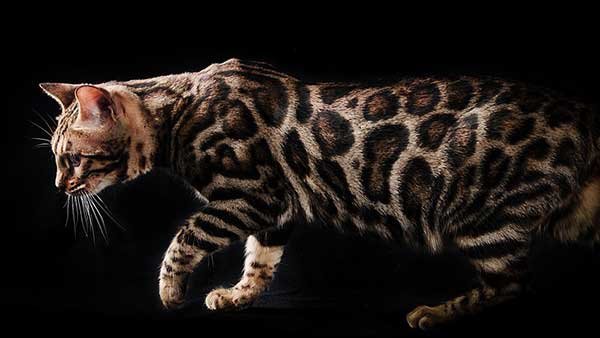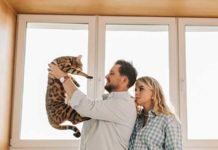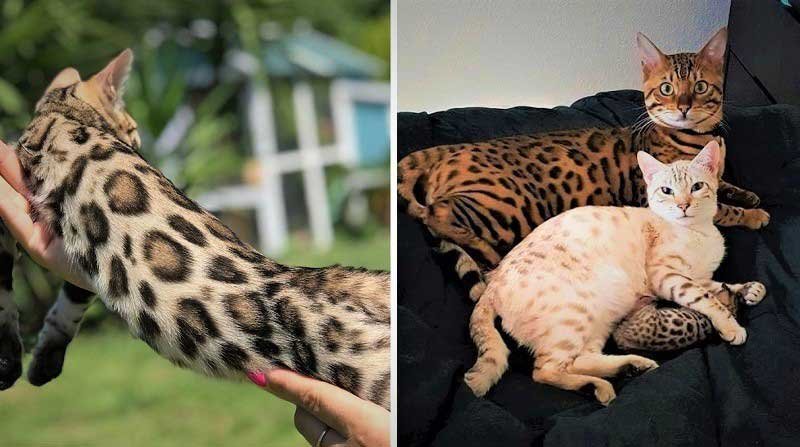Bengal cats are a domestic breed, developed by breeding domestic cats with Asian leopard cats. But, how to tell if your cat is a Bengal?
In this article, we will explore the key characteristics that make a Bengal cat a Bengal, including their coat pattern, size and build, behavior, and pedigree.
By understanding these characteristics, you’ll be able to tell if your cat is a Bengal and appreciate the beauty of this unique breed.
How to Tell if Your Cat is a Bengal?
If you’re wondering if your cat is a Bengal, there are a few key characteristics to look for.
1. Coat pattern
The most distinctive feature of a Bengal cat is its coat pattern. They have a distinctive “glitter” effect, caused by the presence of a gene that makes the hairs on their coat appear to have a metallic sheen.
There are two main types of Bengal coat patterns: spotted and marbled.
Spotted

Bengal cats with a spotted coat pattern have round or oval-shaped spots that are evenly distributed over their body.
The spots can be any color but are typically black, brown, or rust. The background color of the coat can be golden, silver, or snow.
Marbled

Bengal cats with a marbled coat pattern have a swirling or blotchy pattern that is created by the blending of several colors.
The pattern can be complex and can resemble that of a wild cat.
The background color of the coat can be golden, silver, or snow, and the marbled pattern can be black, brown, or rust.
It’s important to note that Bengal cats’ coat patterns can change as they grow, and they can also be affected by lighting and grooming.
A kitten’s coat may appear very different from an adult coat.
Bengal cats with a “Rosetted” pattern are considered a desirable trait in the breed standard.
Rosettes are defined as a round or oval-shaped spots with a dark outline and a lighter center.
The size of the rosette can vary and they can be distributed over the entire body.
2. Size and build
Bengal cats are a larger and more muscular breed than other domestic cat breeds. They have a strong and athletic build, with long legs and a compact body. They are known for being highly active and energetic, which is reflected in their size and build.
Size
Bengals are a medium to large-sized breed, with males typically weighing between 8-15 pounds and females weighing between 6-10 pounds.
Their size can vary depending on their diet, exercise, and overall health.
Body shape
Bengal cats have compact, muscular body that is well-proportioned and balanced. They have a broad chest and a strong, well-defined jaw.
They also have a strong, athletic build, with long legs and a long tail.
Head
Bengal cats have a distinctive head shape, with a strong jaw and a pointed muzzle.
They have large, expressive eyes that are wide-set, and their ears are pointed and set high on their head.
Coat
Bengal cats have short, thick, and luxurious coat that is soft to the touch.
Their coat is typically covered with spots or marbled patterns, with colors that range from golden to rust to brown and a glitter effect.
Tail
Bengal cats have long and flexible tail that is usually thick and bushy at the base.
The tail can be straight or slightly curved and is usually carried with a slight upward curve.
Their size and build reflect their active and energetic nature, which is a hallmark of the Bengal breed.
3. Bengal cat behavior
Bengal cats are known for being highly active and energetic. They are intelligent and curious with strong hunting instincts.
They are also known for being talkative and affectionate with their owners.
Activity level
Bengal cats are known for their high energy levels and need for activity. They are playful and enjoy climbing, jumping, and running.
They need plenty of interactive toys and a cat tree to climb, and they also enjoy playing with water.
Bengals are known to be more active than other domestic cat breeds and may require more exercise and playtime.
Intelligence
Bengal cats are intelligent and curious, they enjoy solving puzzles and learning new things. They can be trained to do tricks and walk on a leash.
They are also known to be very quick learners, they can figure out how to open doors and drawers, or even turn on and off lights.
Affection
Bengal cats are known for being affectionate with their owners. They enjoy being petted and cuddled, and they often seek out their owners for attention.
They are known to be very social animals and can form strong bonds with their owners.
Vocalization
Bengal cats are known for being talkative, they have a wide range of vocalizations, from meows and purrs to chirps and chattering.
They may vocalize more than other domestic cats, and their owners should be prepared for a more vocal pet.
Hunting instinct
Bengal cats have a strong hunting instinct, which can be seen in their playful behavior.
They may enjoy chasing toys, or even small animals such as lizards or birds.
Owners should be careful to keep their Bengal cats indoors and supervise them when they are outside to prevent them from hunting wild animals.
It’s important to note that every cat is an individual and their behavior may vary depending on their personality, environment, and upbringing.
Additionally, early socialization and proper training can help to shape and control the behavior of a Bengal cat.
4. Pedigree
The most definitive way to determine if a cat is a Bengal is to look at its pedigree.
If the cat’s parents were both Bengal cats, or if its lineage can be traced back to Bengal cats, then it is a Bengal.
Registration
Bengal cats that are registered with a reputable cat registry, such as the International Cat Association (TICA) or the Cat Fanciers’ Association (CFA), have a pedigree that can be traced back to the original breeding of domestic cats with Asian leopard cats.
A registered Bengal cat will have a registration number and a pedigree certificate that verifies its purebred status and ancestry.
Breeding generations
Bengal cats are usually divided into generations based on their level of wild ancestry.
The F1 generation is the first generation of Bengal cats that is produced by breeding an Asian leopard cat with a domestic cat. These cats are considered to be the closest to their wild ancestor.
F2, F3, and F4 generations are the descendants of the F1 generation, and so on.
Bengal cats that are four generations or more removed from the Asian leopard cat are considered domestic cats.
Hybrid cats
It’s important to note that not all cats that have a wild-looking coat or a similar appearance are Bengal cats.
Some breeds such as Savannah, Toyger, or Chausie breeds may have similar characteristics.
These breeds are hybrids of domestic cats and other wild cat breeds. They are not considered purebred Bengal cats and do not have a pedigree that can be traced back to the original breeding of domestic cats with Asian leopard cats.
In conclusion, the pedigree is the most definitive way to determine if a cat is a Bengal, as it indicates the cat’s purebred status and verifies its ancestry.
Bengal cats that are registered with a reputable cat registry have a pedigree that can be traced back to the original breeding.
If you’re unsure whether your cat is a Bengal, you can always consult with a veterinarian or a breed expert.
Conclusion
Bengal cats are a beautiful and unique breed that can be identified by their coat pattern, size and build, behavior, and pedigree.
Keep an eye out for these characteristics and you’ll be able to tell if your cat is a Bengal.







